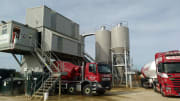- Commercial Spaces
-
Gardens & Driveways
Marshalls Gardens & DrivewaysConsumer Products
-
Builders
Marshalls BuildersBuilding Products
-
About Us
About UsMarketsGovernance
- Sustainability
-
Investor Relations
Investor RelationsShare Price CentreShareholder Centre
-
News & Articles
NewsBlogs
-
Careers
CareersCareers with Marshalls
Managing risk to deliver strategic objectives
Approach to risk management
Risk management is the responsibility of the Board and is a key factor in the delivery of the Group’s strategic objectives. The Board establishes the culture of effective risk management and is responsible for maintaining appropriate systems and controls.
The Board sets the risk appetite and determines the policies and procedures that are put in place to mitigate exposure to risks. The Board plays a central role in the Group’s risk review process, which covers emerging risks and incorporates scenario planning and detailed stress testing.
Our process
There is a formal ongoing process to identify, assess and analyse risks, and those of a potentially significant nature are included in the Group Risk Register.
The Group Risk Register is updated by the full Executive Management team at least every six months and the overall process is the subject of regular review by the Board. Risks are recorded with a full analysis, and risk owners are nominated who have authority and responsibility for assessing and managing the risk. KPMG, as the Group’s Internal Auditor, regularly attends the risk review meetings. The process continues to be a robust mechanism for monitoring and controlling the Group’s principal risks, and for challenging the potential impact of new emerging risks. All risks are aligned with the Group’s strategic objectives, each risk is analysed in terms of likelihood and impact to the business and the determination of a “gross risk score” enables risk exposure to be prioritised. The Marley business has historically utilised a similar risk management process, and this has been mapped across and embedded in the Marshalls risk management process.
The Group seeks to mitigate exposure to all forms of strategic, financial and operational risk, both external and internal. The effectiveness of key mitigating controls is continually monitored, and such controls are subject to internal audit and periodic testing in order to provide independent verification where this is deemed appropriate. The effectiveness and impact of key controls are evaluated and this is used to determine a “net risk score“ for each risk. The process is used to develop detailed action plans that are used to manage, or respond to, the risks, and these are monitored and reviewed on a regular basis by the Group’s Audit Committee.
The Group has a formal framework for the ongoing assessment of operational, financial and IT-based controls. The overriding objective is to gain assurance that the control framework is complete and that the individual controls are operating effectively. Additional independent verification checking of key controls and reconciliations is undertaken on a rolling basis. Such testing includes key controls over access to, and changing permissions on, base data and metadata
Framework
Reviews the effectiveness of the Group’s risk management and internal control procedures; and
Monitors the effectiveness of the internal audit function and the independence of the external audit.
Oversee the management of risk;
Monitor risk mitigation and controls; and
Monitor the effective implementation of action plans.
Report on effectiveness of management actions; and
Provide assurance to the Audit Committee.
Are responsible for ownership and control of specific risks; and
Are responsible for establishing and managing the implementation of appropriate action plans.
Are responsible for the impact of controls (net basis).
Viability Statement
After considering the principal risks on pages 55 to 61, the Directors have assessed the prospects of the Group over a longer period than the period of at least twelve months required by the ‘going concern’ basis of accounting. The Directors consider that the Group’s risk management process satisfies the requirements of provision 31 of the UK Corporate Governance Code. The Board considers annually, and on a rolling basis, a strategic plan, which is assessed with reference to the Group’s current position and prospects, the strategic objectives and the operation of the procedures and policies to manage the principal risks that might threaten the business model, future performance and target capital structure. In making this assessment, the Board considers emerging risks and longer-term risks and opportunities. The aim is to ensure that the business model is continually reviewed to ensure it is sustainable over the long term. Security, flexibility and efficiency continue to be the guiding principles that underpin the Group’s capital structure objectives. The Group’s funding strategy is to ensure that headroom remains at comfortable levels under all reasonable planning scenarios.
For the purposes of the Viability Statement, the Board continues to believe that three years is an appropriate period of assessment as this aligns with the current planning horizon. Although our central forecasting models cover a five-year period, it remains the case that there is less visibility beyond three years. The Construction Products Association’s (‘CPA’) forecasts currently go out to 2025. This remains compatible with the five-year Strategy and the longer-term objectives for our strategic growth pillars over a five-year period. The Group’s financial forecast includes an integrated model that incorporates the Income Statement, balance sheet and cash flow projections. The detailed stress testing reflects the principal risks that could impact the Group and could conceivably threaten the Group’s ability to continue operating as a going concern. The assessment concluded that the deteriorating macro-economic environment is the key risk for this purpose and, in response to this, two scenarios have been run, namely a ‘reasonable worst-case scenario’ and a ‘reverse stress test’.
The reasonable worst-case scenario comprises a significant stress test sensitivity run against the base case model. This sensitivity reflects a scenario that incorporates twice the downside assumed between the CPA’s central case and lower scenario from its 2023/2024 Winter forecast. This scenario results in a cumulative revenue reduction of five per cent during 2024 and 2025 against the base case forecast. An operating ‘drop-through’ rate has been applied based on the operational gearing of each business unit. Under the downside model, net debt reduces to £198 million (£155 million on a pre-IFRS 16 basis) by the end of 2024, and bank covenants are still comfortably met throughout the viability period, to December 2026. The net effect of reduced operating profit is mitigated by reduced tax and dividend cash flows. There remains comfortable headroom against bank facilities and bank covenants are comfortably met with the pre-IFRS 16 net debt to adjusted EBITDA covenant peaking at 1.9 in June 2024. In practice, under such a downside scenario the Group could instigate certain mitigation measures to reduce costs and capacity and to manage cash.
For the purposes of Going Concern assessment, we have applied a reverse stress test scenario to identify a deeper downside trading position that would give rise to a covenant breach. Against the base budget revenue, a reduction of 20 per cent alongside an operating profit ‘drop through’ of around 40 per cent would be required during 2024 to breach a covenant at 31 December 2024. This is after assuming the benefit of £10 million of cost savings, a reduction in capital expenditure and pausing dividend payments. This scenario equates to over nine times the volume downside assumed between the CPA’s central case and lower scenario from its 2023/2024 Winter forecast. This reverse stress test scenario reduces revenue by approximately £135 million during 2024. There remains reasonable headroom against bank facilities, but the EBITA: finance costs bank covenant marginally breaches three times at 31 December 2024.
In undertaking its review, the Board has considered the appropriateness of the key assumptions, considering the external environment and the Group’s strategy and risks. Based on this assessment, and taking account of the Group’s principal risks and uncertainties, the Directors confirm that they have a reasonable expectation that the Group will be able to continue in operation and meet its liabilities as they fall due for the next three years. The reverse stress test scenario provides an indication of the scale of downturn that could be absorbed by the Group. The analysis provides the required evidence for the Directors’ assessment that the going concern assumption remains appropriate and supports a positive conclusion for the longer-term Viability Statement.
Principal risks and uncertainties
The Directors have undertaken a robust, systematic assessment of the Group’s emerging and principal risks. These have been considered within the timeframe of three years, which aligns with our Viability Statement. The risk process has increasingly allocated greater focus on emerging risks and risk outlook. The reporting includes more detailed assessments of proximity (how far away in time the risk will occur) and velocity (the time that elapses between an event occurring and the point at which the effects are felt).
Strategic Objectives
 Obtain and deliver specification
Obtain and deliver specification Easy to work with
Easy to work with Innovate and optimise products and solutions
Innovate and optimise products and solutions Improve our cost effectiveness, our efficiency and our flexibility
Improve our cost effectiveness, our efficiency and our flexibility Operate in an environment where safety and people are a key priority
Operate in an environment where safety and people are a key priority
Macro-economic & political
The Group is dependent on the level of activity in its end markets. Accordingly, it is susceptible to economic downturn, the impact of Government policy, volatility in UK and world markets and supply chain and labour market issues. During 2023, higher interest rates and significant cost inflation have created a cost of living crisis for large elements of the UK population. This uncertainty has impacted market sentiment and this has been exacerbated by the increasing impact of wider geopolitical factors (including the conflict in Ukraine and the Middle East) and the impact of unprecedented levels of Government borrowing. These factors led to a significant reduction in new house building and lower private housing RMI activity.
- Increasing inflation, gilt rates and interest rates.
- An escalation of the war in Ukraine and the Middle East and other increased global uncertainty.
- Reductions in consumer confidence and order pipeline.
• The Group benefits from the diversity of its business and end markets.
• The proactive development of the product range also continues to offer protection.
• The Group undertakes scenario planning to support improved business resilience.
• The Group continues to focus on those market areas where growth prospects are greatest.
• Restructuring activities have reduced the Group’s cost base.
• Focus on innovation, new product development and the ESG-driven opportunities to drive competitive advantage.
No change in risk The UK Government’s stated objective is to support construction and significant investment support for infrastructure and housing is expected over the medium term; however, the short-term outlook for construction continues to be weak. The economic slowdown has resulted in a loss of business and consumer confidence in 2023, leading to delays in investment decisions. It appears increasingly likely that the current interest rate cycle has peaked leading to lower borrowing cost expectations which should support increasing activity levels in the Group’s key end markets.
Priorities
• Regular scenario planning to assess various market risks and disruptive events.
• Strategic reviews focusing on business resilience and diversification.
• Increase operational efficiency and maintain flexibility in the manufacturing network.
Cyber security risks
Constantly evolving and indiscriminate risk of cyber-attack.
Inadequate controls and procedures to protect intellectual property, sensitive employee information and market influencing data.
The failure to improve controls against cyber security risk quickly enough, given the rapid pace of change and the continuing threat of ransomware and denial of service attacks, as well as any new cyber threats.
Heightened risk as IT is increasingly integrated into all business processes including the industrial network and equipment.
The introduction of AI-led attacks which make it harder to identify, prevent and mitigate due to the increased sophistication.
Operational disruption and financial loss due to the increased dependence on IT from the Group’s industrial and corporate networks and equipment. As well as data loss, fraud and fines causing financial and reputational risk.
- Emergence of new and evolving cyber security risks.
- Increased examples of data loss and security breaches in the wider market, with specific focus on manufacturing and construction.
• Regular external cyber security risk audits undertaken by specialists and the use of industry recognised controls and procedures.
• Annual penetration and vulnerability tests of external and internal systems and networks.
• A continuous programme of awareness, training, and phishing simulation for staff.
• Appropriate tools and training procedures are in place to protect sensitive data when stored and transmitted between parties.
• Industry-recognised cyber security tools and software.
• Cyber insurance to cover business interruption, loss of earnings and response services for the majority of the Group.
• Deployment of additional controls to help prevent and respond to a ransomware attack.
• Improvements and testing of our incident response process including business-wide simulations and playbooks.
The Group’s cyber maturity assessment continues to improve but cyber remains a high‑profile area. We are witnessing more incidents, especially in the construction industry. Improvements have been made to the cyber control environment in Marley to bring it in line with that of Marshalls; however, this continues to be an area of focus. Considerable effort continues to be given to promoting awareness of cyber security threats and our own IT security policies. The risk of data loss through new (or unknown) security threats continues to increase
Priorities
• Bolster our controls of our industrial network and equipment.
• Continue to develop cyber risk strategy.
• Alignment of controls in Marley.
• Improve our cyber security response plans and identify and rectify any gaps
Security of raw materials
Globally, the impact of the ongoing Ukrainian and Middle East conflicts coupled with general energy supply continues to impact material availability and has resulted in significant cost inflation. There continues to be availability issues with imported materials and longer term there is a risk of “carbon taxation”.
Cost inflation or interruption of supply could lead to customer dissatisfaction and reduce demand and margins.
• Decreases in labour availability and skills shortages, particularly in engineering.
- The Group benefits from the diversity of its business and end markets.
- The acquisition of Marley has increased diversification and created additional procurement opportunities.
- Maintaining adequate, but not excessive, stocks.
- Collaboration with all EU-based tier one and tier two suppliers to ensure any supply risks are minimised.
- The digitalisation of the supply chain through the implementation of a best-in-class Supply Relationship Management System.
- The Group focuses on its supplier relationships, flexible contracts and long-term supply agreements, the use of hedging instruments and the use of flexible freight forwarding options.
- The Group utilises sales pricing and purchasing policies designed to mitigate the risks.
- Consideration of alternative technologies, including the reduction of cement content.
Reduced risk
Continued weak demand has led to reduced availability issues, although cost inflation has continued.
The risk of temporary shortages is mitigated by proactive supply chain management and the use of alternative suppliers.
Priorities
• Increase productivity and manufacturing efficiency.
• Continue to develop supply chain strategies to reduce risk
Climate change
- Negative feedback from stakeholders – loss of business and investment.
- Failure to meet internal targets.
• Clear governance structure and reporting processes in place. ESG Board Committee meetings supported by an experienced ESG Steering Committee with Executive and Board level representation. This is further supported by an ESG Delivery Team with responsibility for delivering the ESG strategy.
• Specialist third parties including the Carbon Trust and Verisk Maplecroft (see further details on pages 44 and 45).
• Climate risk analysis.
• Agreed carbon reduction plan and a set of KPIs established.
• The Group is committed to the SBTi and a new Group plan is now being developed to include the impact of the Marley business on our Group carbon footprint.
• Working groups established in all focus areas and controls being progressively embedded across the business, including the Climate Disclosures Working Group.
No change in risk
Significantly heightened focus from stakeholders, Government, customers and investors. Expectation of clarity over financial impact of strategic plans and transition risk. TCFD and CFD disclosure requirements.
Priorities
• Integration of Marley into the Group’s ESG policies and procedures.
• Re-calculation of carbon reduction targets and net zero timeline to include Marley.
• Ongoing assessment of climate change and risks for production, facilities, products and distribution.
• Monitor progress on strategy covering targets, products and business processes.
• Review of opportunities to improve ESG reporting
Human Rights
Lack of visibility of human rights within the supply chain. Increased global attention on modern slavery and diversity reporting. The continuing requirement to identify risk across the whole supply chain and the need to maintain reliable and consistent internal systems, processes and procedures. A summary of more specific social risks is included in the Sustainability section on pages 38 to 43.
Risk that stakeholders could reduce support if the Group failed to address issues around modern slavery and diversity appropriately.
• Negative feedback from stakeholders – loss of business and investment.
• Inadequate data to support systems and procedures.
• Increase in general level of disclosure required and administrative compliance.
• Failure to make tender lists if basic due diligence requirements are not met.
- Human rights strategy oversight by the ESG Steering Committee and revised ESG governance framework.
- The Group utilises experienced, specialist staff to support the Group’s focus in this area and the development of a comprehensive strategy.
- Regular internal cross-functional meetings to discuss progress, issues and focus areas.
- Specific supply chain human rights training for entire procurement team.
- Annual analysis of sourcing country risk.
- Focus on ethical sourcing processes with BES 6001.
- Working groups established in all focus areas
Reduced in risk
Focus from stakeholders, Government, customers and investors and increased operational and reporting requirements. Disposal of the business in Belgium reduces this risk for the Group.
Priorities
• Strategic partnership working with stakeholders including UK and overseas governments, NGOs and industry groups.
• Increase focus on the development of the Group’s comprehensive strategy.
• Develop robust IT platform for data collection and analysis.
• Use of independent third-party audits to cover more regions and product lines
Impact of weather events
Increasingly unpredictable weather conditions and extreme weather events. Increased incidence of flooding and droughts across the country. The longer-term implications of climate change give rise to the transition risk of not addressing the challenges quickly enough.
Disruption to supply chain and operations that might reduce short-term activity levels. Operational difficulties at manufacturing sites due to flooding and droughts. Financial risk caused by adverse impact on margins and cash flows as well as sales and production volumes
• Prolonged periods of bad weather (e.g. snow, ice and floods) which make ground working difficult or impossible.
• Changing public perceptions of the longer-term implications of climate change
• The Group utilises centralised specialist functions to support mitigation plans and the management of relationships on commercial contracts.
• Climate change risk analysis in place.
• Commitment to water harvesting and recycling schemes.
• The development of resilience strategies for climate change is a key element of the Group’s Climate Change Policy.
• The development of the Group’s Water Management business and the continuing focus on new product development
Reduced in risk
Weather conditions continue to be closely monitored but are beyond the Group’s control.
Significant increase in public awareness of climate change.
Priorities
• Continue to develop resilience strategies.
• Development of Civils and Drainage business
Threat from new technologies & new business models
Reduction in demand for traditional products. Risk of new competitors and new substitute products appearing although this risk is set against a challenging 2024 outlook. Failure to react to market developments, including digital and technological advances. Competitor application of AI to add value to customer offer.
The increased competition could reduce volumes and margins on traditional products. Increased costs and production capacity tied up in redundant technologies. There is also the risk that a disruptor could use emerging digital technology to enter the market through non-traditional routes to market. Loss of business to competitors who deliver advantage through AI.
- Less demand for traditional products and routes to market.
- Emergence of new competitors and new digital business models.
- More widespread availability of artificial intelligence technology.
• Flexible business strategy able to embrace new technologies.
• Significant focus on research and development and new products.
• A focus on the ease of doing business with the Group.
• Specification strategy to keep us close to customers.
• Use of AI in quotation process
No change in risk
The ongoing diversification of the business, the continued development of the Group’s brands and the focus on new products and greater manufacturing efficiency continue to mitigate the risk. The pace of digital change in the market continues to increase although this is balanced by a challenging outlook.
Priorities
• Increase pace of digital change and technological solutions (e.g. Dropship).
• Focus on cost reduction and projects that improve business flexibility and agility
Corporate, legal & regulatory
Inadvertent failure to comply with elements of a significantly increased governance, legislative and regulatory business environment. The Group may be adversely affected by an unexpected reputational event, e.g. an issue in its supply chain or due to a health and safety incident, media, NGO exposé on a sector, region or supplier.
Significant increases in the penalty regime across all areas of business (e.g. health and safety, competition law, the Bribery Act and GDPR) could lead to significant fines and/or prosecution in the event of a breach.
A health and safety or environmental incident could lead to a disruption to production and the supply of products for customers. Such incidents could lead to prosecutions, increased costs and have a negative impact on the Group’s reputation.
• Integration requirements for new acquisitions.
• Significant increases in the penalty regime for health and safety and environmental incidents. Penalty regimes becoming generally more punitive.
• Centralisation of certain Marley functions into the central legal team.
• Regular reviews of policies and procedures.
• Regular compulsory data protection training.
• The Group has a formal Group ESG strategy focusing on impact reduction.
• The Group employs compliance procedures, policies, ISO standards and independent audit processes which seek to ensure that local, national and international regulatory and compliance procedures are fully complied with.
• The Group uses professional specialists covering carbon reduction, water management and biodiversity.
No change in risk
The significant increase in governance requirements and regulation continues to require additional management focus and robust compliance procedures within all areas of the business.
Priorities
• Continue to review and, where appropriate, renew all compliance processes and control effectiveness.
• Develop stress tests and crisis planning procedures
Competitor activity
The Group has a number of existing competitors which compete on range, price, quality and service. Potential low price competitors may be attracted into the market despite the challenging outlook in 2024.
Competitive risk increases if we fail to achieve a sustainable competitive advantage through our approach to customer service and innovation.
Increased competition could reduce volumes and margins on manufactured and traded products.
Erosion of brand equity if the Group loses competitive advantage.
• Less demand for traditional products and the increased emergence of new digital business models and product solutions.
• Gross margins under pressure.
• The Group has unique selling points that differentiate the Marshalls branded offer.
• The Group focuses on quality, service, reliability and ethical standards that differentiate Marshalls from competitor products.
• The Group has a continuing focus on new product development.
• The continued development of the Group’s digital strategy and its focus on customers and all stakeholders.
• Restructuring programme implemented in 2023 will reduce cost base to support market competitiveness
Increase in risk
Risk that competitors accept lower margins putting pressure on the Group to reduce pricing.
Priorities
• New product development.
• Research into green technologies.
• Review marketing and communications.
• Continue to review all elements of customer service, including the continuing development of KPIs.
• Develop low-cost supply chain routes.
Project delivery
Ineffective management of major development projects, from initial scoping to final delivery and benefits management, due to constraints that might impact the Group’s ability to absorb change. During 2023 such projects included the implementation of the D365 ERP system in the Marshalls businesses, the construction and commissioning of the dual block plant at St Ives and the successful implementation of a series of major restructuring programmes.
The extent and complexity of projects may cause delays and inefficiency. Potential failure to realise expected benefits from strategic business projects. Reputational damage, service under-delivery and staff retention risks.
- Delays to project delivery.
- Inefficiencies in resource utilisation.
• Change management framework and process in place.
• Programmes are continually reviewed with strong governance and Executive oversight, including project-specific steering committees where appropriate.
No change in risk
Although the underlying risk continues, effective control and the ongoing development of an appropriate management framework continue to mitigate the risk.
Priorities
• Develop strategies to manage growth.
• Ongoing reviews of acquisition strategy and the business model.
Health and safety
Unexpected health and safety incident, possibly caused by human error or the actions of a subcontractor. Ongoing risks in relation to maintaining safe working environments and ensuring compliance with health and safety legislation. Ongoing welfare and mental health of employees.
• Increase in HSE contravention notices
• Regular communication and support for employees, including those working from home.
• Mental Health First Aiders.
• Group-wide health and safety strategy recognised through OGSM framework.
• Ongoing monitoring, training and health and safety audits.
• Introduction of a digital management system for enhanced data collection and analysis.
• All senior managers receive the Marshalls Health and Safety and Environmental stage 3 training.
No change in risk
Health and safety continues to be a high profile risk area. Increased visits from HSE to our factories over the last two years. Continuing risks include mental health and employee welfare.
Priorities
• Ensure health and safety embedded in the “day-to-day” culture.
• Improve reporting structures.
• Implementation of High Risk Activity (“HRA”) programmes.
• Implement Group health and safety management system into Marley.
People Risks
• Reduced productivity and efficiency due to skills gap.
• Increased levels of voluntary staff turnover.
• Increased stress levels within workforce and potentially absenteeism.
• Employee relations becomes increasingly key as we drive change
• Group People and Organisational Plan with focused plans in each area.
• Strong employee and trade union relationships.
• Strong communication channels and employee feedback through the EVG.
• Regularly seeking employee feedback via surveys and through the EVG.
• Ongoing focus on training, apprenticeships and staff development and leadership potential
Increase in risk
People continue to be a priority focus for the Group including development, health and safety and wellbeing, especially against the backdrop of business challenges seen throughout 2023. This includes multiple restructuring exercises which have adversely impacted engagement levels. The labour market continues to be competitive with people increasingly seeking roles and organisations which offer a wider proposition including development.
Priorities
• Focused people plans across the Group building on retention and recruitment strategies.
• Focus on succession planning, development and diversity in the leadership teams.
• Continued effective communications.
































































































